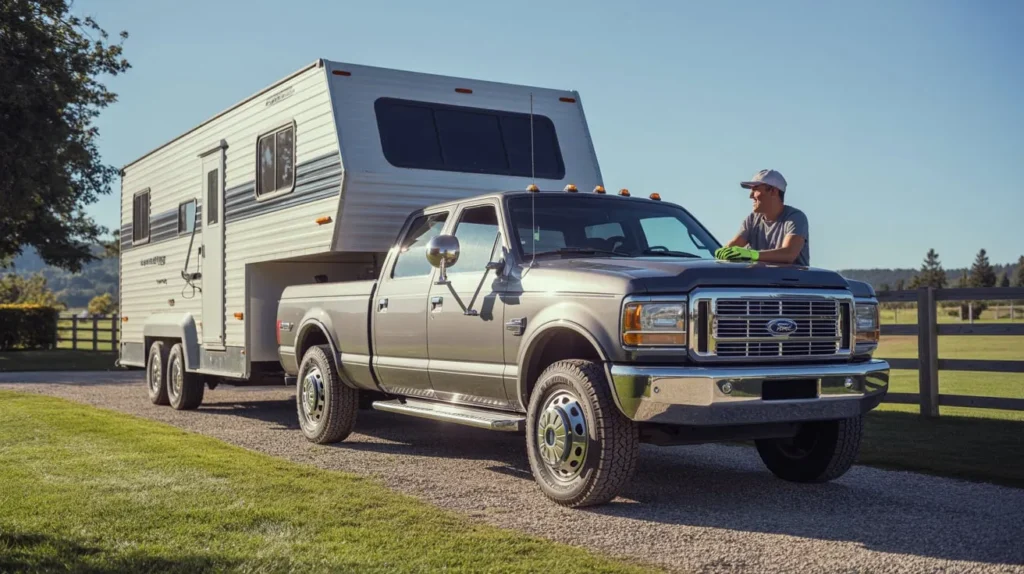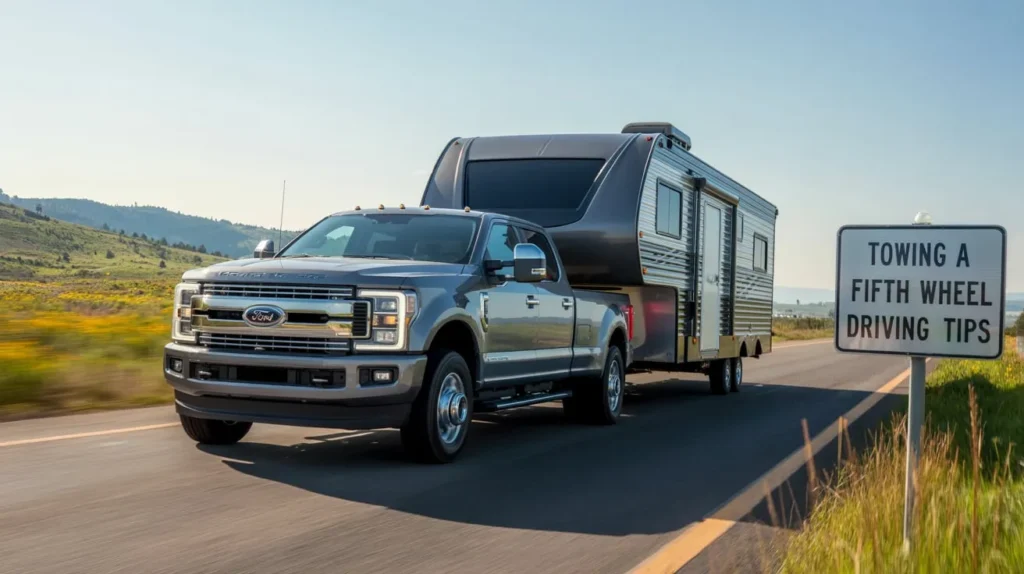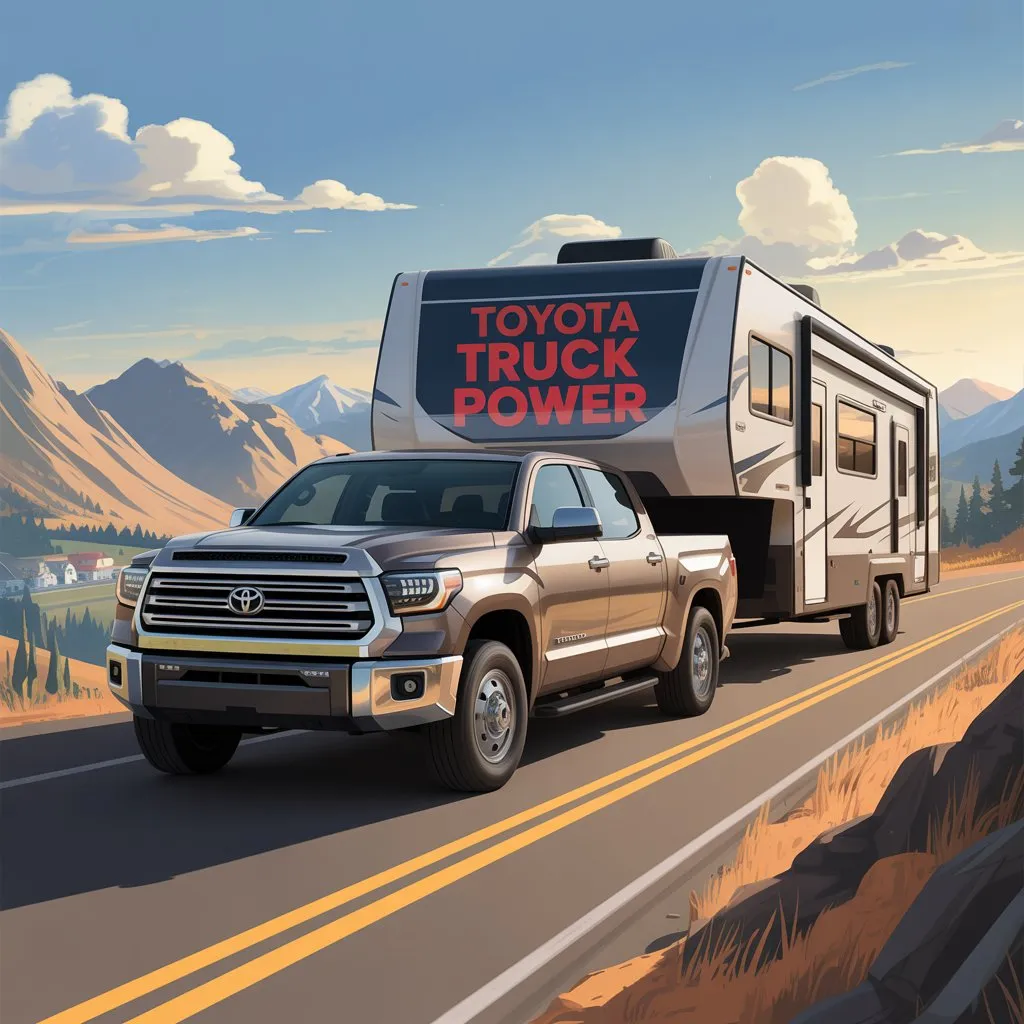Fifth wheel towing can be an exciting experience especially when you have a powerful truck such as the Toyota Tundra. The Tundra with its sturdy construction and high towing capacity provides a solution to those who want to take memorable road trips or weekend getaways in their fifth wheel trailers. Being a Toyota Tundra and a fifth wheel owner, I can confirm that the two are compatible, and this makes traveling on different terrains smooth.
A fifth wheel is unlike a traditional travel trailer as it has a special hitching system that attaches to the bed of a pickup truck, such as the Tundra. This design increases stability during towing, and this is why it is a favorite among frequent travelers. Fifth wheel trailers are usually designed higher, and thus they can have more living space, which is more comfortable and has more amenities, and this is attractive to both families and adventure-seekers.
The decision to tow a fifth wheel using the Toyota Tundra is not only about the ability to do it, but also about the fun of exploration. Planning a cross country trip or a local camping trip, it is important to know whether your vehicle can support the load or not. The Tundra is in this regard, and it has a great towing capacity that differs according to the year and model of the Tundra. In this guide, we are going to dive into the details of towing a fifth wheel with a Toyota Tundra, including weight limits, required equipment, and useful tips to make the process safe and enjoyable. This post will provide you with the information you need to make an informed choice regarding your towing adventures with detailed information and expert guidance.
What are Fifth Wheel Trailers?
Fifth wheel trailers are also common among RV enthusiasts and people who want a more stable towing experience. Unlike conventional travel trailers, these vehicles have a special design with a raised front portion that is directly attached to the towing vehicle through a special hitch attached to the truck bed. This design enables better weight distribution and maneuverability during camping or travelling.
Fifth wheel trailers have many advantages, which is why they are a choice of many travelers:
Greater Stability:
The hitching system provides greater stability when towing, decreasing sway and providing more control on the road.
Roomy Interiors:
Fifth wheels usually have more roomy living areas than other RVs, which is advantageous to people who want to have more home-like comfort.
High Design:
The high gooseneck design can usually enable higher ceilings and greater vertical space to occupants.
Flexible Use:
Fifth wheels are commonly used as campers, full-time residences, or mobile homes and can be used in many lifestyles.
Improved Sleeping Capacity:
Most fifth wheel models have the capacity to sleep more people comfortably.
When it comes to a fifth wheel, it is important to mention the size and weight capacities. These trailers are usually between 20 to 40 feet long, which makes them have a weight capacity of 5,000 to more than 16,000 pounds. Therefore, a well-equipped towing vehicle like the Toyota Tundra should be able to tow the weight and travel safely.
In general, fifth wheel trailers are both functional and comfortable, which makes them a good choice of people who are interested in towing large vehicles and preserving the livable space and accessibility. Their increased popularity among RV enthusiasts speaks to their usefulness in long-distance travel and outdoor adventures.
Toyota Tundra Specs and Towing Capacity
Toyota Tundra is a powerful car that has become popular among truck lovers especially in towing. The Tundra can carry heavy loads with its strong design and powerful engine choices. The Tundra has a towing capacity that depends on the model year and configuration, but typically is between 8,000 and 12,000 pounds. This capacity puts it in a good position to tow fifth-wheel trailers that may weigh more than 10,000 pounds.
The Tundra is fitted with various engine types that have a great impact on its towing capacity. The regular 5.7-liter V8 is very powerful and can tow heavy loads. To the people who are thinking of a more fuel-efficient model, the newer models also have a twin-turbo V6 engine that although it has lower torque, still has competitive towing capacities.
To further help the potential buyers, the table of specifications below describes different models of Tundra and their towing capacities:
| Model Year | Engine Type | Towing Capacity (lbs) | Payload Capacity (lbs) |
| 2021 | 5.7L V8 | 10,200 | 1,730 |
| 2022 | 3.5L Twin-Turbo V6 | 12,000 | 1,940 |
| 2023 | 3.5L Twin-Turbo V6 | 12,000 | 1,940 |
This variation in specifications underscores the reason why the Toyota Tundra is commonly considered as a perfect choice when it comes to towing fifth-wheel trailers. It is a powerful, reliable, and technologically advanced vehicle, which is why it is a preferred option when it comes to a reliable towing vehicle.
Does the Toyota Tundra Pull a Fifth Wheel? An Analysis
In determining the ability of a Toyota Tundra to tow a fifth wheel, it is important to look at some of the main factors such as the maximum towing capacity of the truck, the weight of the typical fifth wheel, and the consequences of matching these two values to allow safe towing. Toyota Tundra is known to be a powerful vehicle, and different models have towing capacities that are usually between 8,000 and 12,000 pounds, depending on the configuration and equipment. This broad span provides good towing capabilities to most fifth wheel trailers.
The weight of the fifth wheel trailers differs greatly, but the majority of them are between 5,000 and 12,000 pounds. When considering compatibility with the Tundra, it is essential to consider the particular model of a fifth wheel. As an example, lightweight fifth wheel trailers of about 5,000 to 7,000 pounds can be easily towed by the lower-end Tundra configurations, but heavier trailers might need a higher trim level with a more powerful engine, such as the 5.7L V8 available on the Tundra.
When it comes to safe towing, it is recommended that one should follow a standard of not more than 80 percent of the maximum towing capacity of the vehicle. This rule will reduce the dangers of towing, increasing stability and control and allowing a margin of error in the weight of the cargo and roadside conditions. Furthermore, the prospective purchasers ought to take into consideration the incorporation of appropriate towing gear, such as a stable hitch that can support the particular weight of the fifth wheel, to guarantee safety and compliance with the law.
To sum up, the Toyota Tundra can tow a fifth wheel with a little bit of thought and the right gear. The potential Tundra owners are advised to compare their personal requirements with the specifications of the truck to make a reasonable choice concerning compatibility and safety of their towing lifestyle.

Towing a Fifth Wheel Preparation
There are a number of preparations that need to be made before towing a fifth wheel using a Toyota Tundra to make the experience safe and efficient. This preparation entails a number of important aspects such as installation of hitch, vehicle inspections, weight distribution, and obtaining the required gear.
To begin with, it is important to install hitch. A fifth wheel needs a special hitch which is firmly attached to the truck bed. The owner manual or a professional should be consulted to know the correct hitch that fits your model of Toyota Tundra. Make sure that the hitch has the necessary weight capacities of the desired fifth wheel. The correct installation is to tighten all the bolts to the manufacturer specifications and ensure that the hitch plate is level in the bed of the truck.
Vehicle inspection is also important. Before towing, make sure to check your Toyota Tundra brakes, suspension, tires, and lights to make sure they are in good condition. All these parts are essential in managing the extra weight of a fifth wheel. Take particular note of the tow rating of your vehicle; the Toyota Tundra has a strong towing capacity, but it is necessary to ensure that it can support the combined weight of the trailer and the cargo.
Another important consideration when towing is to have the right weight distribution. Use weight distribution hitches to ensure that the load is balanced, and this will improve the stability of towing. Also, make sure that the fifth wheel weight does not exceed the tow limit of your Tundra. Balancing is done properly so that the vehicle can be controlled on the road.
Lastly, think of the equipment required to tow safely. Safety chains, brake controllers, and a good electrical connection between the truck and the trailer are essential tools. To make this preparation process easier, it is possible to create a detailed checklist. These steps will help to make the process of towing a fifth wheel with a Toyota Tundra much safer and more effective.

Towing a Fifth Wheel Driving Tips
A fifth wheel can be an exciting experience to tow using a Toyota Tundra, but it requires certain driving skills to make it safe and manageable. The peculiarities of towing a trailer require increased attention, particularly to acceleration, braking, turning, and parking. All these aspects need modifications as compared to normal driving.
When accelerating when towing, it is imperative to accelerate slowly to avoid the trailer swaying. Sudden acceleration may cause undesired motion of the trailer, which makes it less stable. It is a good rule of thumb to give plenty of room when entering traffic to compensate the additional weight of the trailer. In addition, when starting off at a stop, make sure you are in a lower gear so that you can have more control over the vehicle and trailer.
Braking should also be considered; it is important to begin braking earlier than normal. The extra weight of the fifth wheel implies that your braking distance has been greatly increased. Make use of the engine brake to assist in slowing the vehicle down, particularly on downhill slopes. The method minimizes the load on your brakes and improves control.
A very important thing to learn is turning with a trailer. It is important to remember to turn wider than usual to allow the length of the trailer. Signal your intentions to other drivers early enough and anticipate turns. In addition, monitor your mirrors to make sure that the truck and the trailer are aligned in the maneuver.
Parking a towing arrangement has its own difficulties, primarily because of the trailing weight. As much as possible, find places that have a lot of space, where one can move freely. Make use of your mirrors; they can provide a critical perspective of the trailer location and can reduce blind spots. The other thing that should be considered is to apply the parking brake when the vehicle is not in motion and both the Tundra and the fifth wheel should be firmly in position, particularly on slopes.
It is also important to understand trailer sway. Sway may be caused by windy conditions or sudden maneuvers and it can be controlled by ensuring a constant speed and not making sudden direction changes. In case of swaying, slow down gently and straighten the steering wheel to take control rather than overcorrect.
Towing Common Problems and Solutions
The process of towing a fifth wheel using a Toyota Tundra may have certain issues that require consideration and planning. By solving these issues, safety and performance will be improved on the road. A typical problem is the handling of the additional weight of fifth-wheel trailers. The Tundra is able, but it should be adequately equipped to support the weight of the trailer, particularly with respect to payload limits and towing capacities. An appropriate weight distribution hitch may assist in stabilizing the load, distributing weight evenly and enhancing the handling of the vehicle.
The other major problem is towing in unfavorable weather. Stability and control may be influenced by rain, snow, or strong winds. In such circumstances, it is important to slow down and increase the following distance to accommodate the additional stopping distance needed when towing a trailer. Towing-specific tires and monitoring tire pressure may help improve traction and safety on wet or icy roads.
Towing a fifth wheel is also difficult on steep inclines. The Toyota Tundra has a powerful engine, but it is necessary to choose the gears carefully when driving on steep grades. Activating the tow/haul mode will help to optimize engine performance by changing the transmission shifts to assist in managing the load. You should learn to use engine braking to regulate your speed on downhill grades, and use less of the brakes, which will overheat and fail when used continuously.
Also, the weight distribution and sway control are crucial elements of safe towing. To ensure that the load is well distributed can greatly minimize the trailer sway which is a key to control. This can be further reduced by the use of anti-sway technology that gives one peace of mind as they drive through various terrains. With these challenges in mind, owners can make the most out of their towing experience with the Toyota Tundra.
Frequently Asked Questions (FAQs)
1. How much can a Toyota Tundra tow?
The towing capacity of the Toyota Tundra is different according to the model year and configuration. In general, the current Tundra models have the capacity to tow 8,000 to 10,200 pounds. The actual towing capacity of your vehicle is critical to the capability of towing a fifth wheel and should be consulted in the specific owner manual or the official specifications of Toyota.
2. Does a Toyota Tundra pull a fifth wheel?
Yes, a Toyota Tundra can pull a fifth wheel, but the weight of the fifth wheel must be within the towing capacity of the Tundra. You should make sure that the gross vehicle weight rating (GVWR) of the fifth wheel is within the towing capacity of the vehicle before towing. Proper hitch that is used to tow the fifth-wheel is crucial to safety and efficiency.
3. What kind of hitch do you need to tow a fifth wheel?
A fifth-wheel hitch is required to tow a fifth wheel using a Toyota Tundra. Fifth-wheel hitches are made to distribute weight more evenly and offer more stability. When selecting a hitch, it is necessary to consider the size of the bed of the Tundra and the RV being towed so that a secure and safe connection is made.
4. What does it take to maintain towing a fifth wheel?
In towing a fifth-wheel trailer, it is important to maintain both the Toyota Tundra and the trailer regularly. Make sure that the brakes, tires and transmission fluid of the vehicle are in good condition. Also, inspect the fifth-wheel hitch and trailer connections to see if they are worn or damaged. Regular checks on the road will ensure that problems do not occur.
5. Do any weight distribution systems need to be used?
Although it is not required, a weight distribution system may enhance stability and control during the towing of a fifth wheel. This system assists in spreading the weight of the trailer more evenly over the towing vehicle and this minimizes the chances of swaying. It is especially helpful with heavier fifth-wheel trailers so that towing is smooth.
6. What is the Tundra like on steep grades when towing?
Toyota Tundra has the latest powertrain technology that is capable of steep grades when towing a fifth wheel. Tow/haul mode is one of the features that can be used to optimize engine performance and avoid gear hunting on uphill. Nevertheless, the driver must be aware of his/her speed and braking distance, particularly when the load is heavy.
Conclusion
To sum up, it can be stated that Toyota Tundra can be considered as a good choice to tow a fifth wheel, but only under certain conditions. In this guide, we have talked about some of the factors that affect the towing capacity of the Tundra, such as towing capacity, the kind of fifth wheel, weight distributions, and hitching methods. The most important thing is to use the right specifications because the towing capacity of the Tundra is different according to the model year, engine, and configuration.
It is worth mentioning that although the Toyota Tundra is designed to perform heavy towing tasks, it is vital to ensure that you do not exceed the recommended limits as this will not only affect the performance of the vehicle, but also its safety. Preparation is crucial to a positive towing experience, and this includes but is not limited to knowing the limitations of the vehicle, learning safe towing practices, and conducting regular inspections of the truck and the fifth wheel before setting out on a trip.
Being a potential Tundra owner or an owner who is considering towing a fifth wheel, it is important to be well informed about your vehicle and the needs of your particular fifth wheel. Towing with a Tundra can be simple and fun by following the instructions of the manufacturer and doing proper planning. Make sure to take your time to research and do not be afraid to contact experienced towing professionals in case you need some advice. In the end, the Toyota Tundra can be a good companion to your towing activities, helping you to have memorable experiences on the road, with the right approach.
Also Read:

